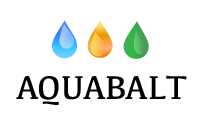Industrial reverse osmosis systems
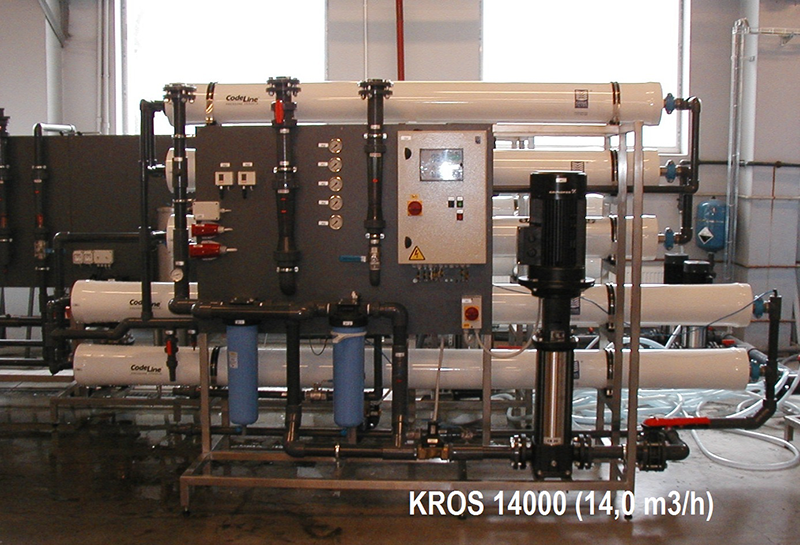
KROS series reverse osmosis installations are designed for water desalting. The instalattion is based on membrane technology that uses the effect of reverse osmosis. In the reverse osmosis installation (ROI) water under hydraulic differential pressure which is created between two sides of the membrane, is devided into permeate (desalted water) and concentrate (high salinity water). The permeate is used for manufacturing, but the concentrate is completely discharged into sewers or partly re-fed to the input of the membrane (returnable concentrate).
Where reverse osmosis technology is used?
The leading consumers of water which is purified using this technique are various companies in the food, metallurgical, petrochemical, pharmaceutical, perfume industry, housing facilities.
As one of the leading water purification methods, reverse osmosis is used when you want to get a very high quality clean water. Flow of water is divided into two: the first flow (filtrate - PERMEATE) almost completely desalted and will be used in manufacturing, the other flow contains salt (concentrate - CONCENTRATE) is discharged into the sewer.
High-quality composit membranes with 99,9% of selectivity are used in the system.
It should be noted that in order to increase the reliability and efficiency of the method the system should be cleaned regularly.
Components of reverse osmosis system
You can select and buy the most comfortable and easy to use systems that have automatic control. Reverse osmosis process can be carefully controlled by couple devices. Furthermore, it increases the safety and usability of such a system as reverse osmosis. Reverse osmosis system consists of the following elements:
- stainless steel frame;
- prefilter;
- PVC or polypropylene panel for installation of the control unit and power supply of the reverse osmosis system;
- housing and high pressure pumps;
- membranes with a high selectivity;
- manometer, pressure gauges, flow meter;
- faucets and valves for water sampling before and after reverse osmosis process;
- electronic microprocessor controller;
- electrical protection.
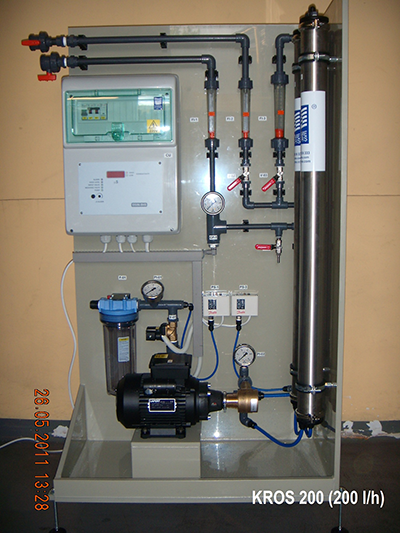
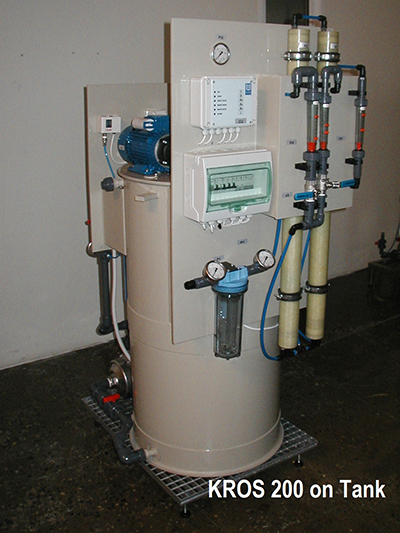
Some systems may also include other additional elements that make the process such as reverse osmosis, even more simple and convenient. Furthermore, they are able to increase its efficiency.
The systems include devices such as membrane disinfication systems and membrane chemical treatment. They can significantly reduce the cost of system maintenance for a process such as reverse osmosis. At the same time, the quality of the final product remains consistently high.
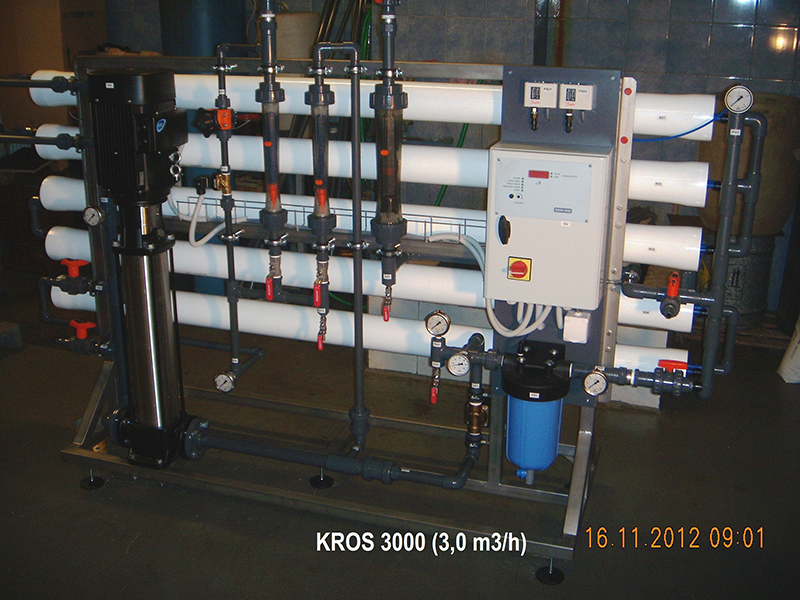
Our company has a high-quality reverse osmosis systems. Note that our specialists not only sell the systems, but also install them. Of course, the cost of such systems is quite high, but our experts will choose filters and other equipment that will satisfy your requirements.
Specifications of the system for water desalination series KROS:
| Cipher | Serie |
Performance* (m3/hour) |
Pressure (bar) | Output coefficient |
Electrical power (кВт) |
Input/Output/Drainage (inch) |
Weight (kg) |
Dimensions H х L х W (mm) |
| А | KROS 100 | 0,1 | 12,0 | 75 | 1,0 | ½"-⅜"-⅜" | 70 | 1220х1000х300 |
| KROS 200 | 0,2 | 12,5 | 75 | 1,0 | ½"-⅜"-⅜" | 80 | 1220х1000х300 | |
| С | KROS 300 | 0,3 | 12,0 | 75 | 2,2 | ¾"-¾"-¾" | 130 | 1660x650x625 |
| KROS 600 | 0,6 | 12,5 | 75 | 2,7 | ¾"-¾"-¾" | 150 | 1660x650x625 | |
| KROS 900 | 0,9 | 12,5 | 75 | 3,7 | ¾"-¾"-¾" | 165 | 1700x850x700 | |
| KROS 1200 | 1,2 | 12,5 | 75 | 3,7 | ¾"-¾"-¾" | 225 | 1830x1100x920 | |
| М | KROS 1500 | 1,5 | 13,0 | 75 | 3,7 | 1"-1"-1" | 260 | 1460x2800x880 |
| KROS 1800 | 1,8 | 12,5 | 75 | 3,7 | 1"-1"-1" | 290 | 1460x2800x880 | |
| KROS 2100 | 2,1 | 13,0 | 75 | 4,0 | 1"-1"-1" | 315 | 1460x2800x880 | |
| KROS 2400 | 2,4 | 13,0 | 75 | 4,0 | 1"-1"-1" | 345 | 1460x2800x880 | |
| KROS 2700 | 2,7 | 13,5 | 75 | 4,0 | 1"-1"-1" | 370 | 1460x2800x880 | |
| KROS 3000 | 3,0 | 13,5 | 75 | 4,0 | 1"-1"-1" | 400 | 1460x2800x880 | |
| В | KROS 3000 | 3,0 | 9,0 | 75 | 4,0 | 1"-1"-1" | 355 | 1750x3300x1000 |
| KROS 4000 | 4,0 | 9,0 | 75 | 4,0 | 1"-1"-1" | 415 | 1750x3300x1000 | |
| KROS 5000 | 5,0 | 9,5 | 75 | 4,5 | 1½"-1½"-1½" | 510 | 1750x3300x1000 | |
| KROS 6000 | 6,0 | 9,5 | 75 | 4,5 | 1½"-1½"-1½" | 620 | 1750x4300x1100 | |
| KROS 7000 | 7,0 | 11,0 | 75 | 5,5 | 1½"-1½"-1½" | 635 | 1750x4300x1100 | |
| KROS 8000 | 8,0 | 10,0 | 75 | 6,0 | 1½"-1½"-1½" | 710 | 1750x3300x1000 | |
| KROS 9000 | 9,0 | 11,0 | 75 | 8,0 | 1½"-1½"-1½" | 760 | 1750x4300x1000 | |
| KROS 10000 | 10,0 | 11,5 | 75 | 8,0 | 1½"-1½"-1½" | 865 | 2000x4300x1100 | |
| KROS 12000 | 12,0 | 11,5 | 75 | 8,0 | 2"-2"-2" | 950 | 2000x4300x1100 | |
| KROS 14000 | 14,0 | 11,0 | 75 | 12,0 | 2"-2"-2" | 1050 | 2000x5500x1200 | |
| KROS 16000 | 16,0 | 10,0 | 75 | 15,5 | 2"-2"-2" | 1200 | 2000x6500x1200 | |
| KROS 18000 | 18,0 | 11,5 | 75 | 22,0 | 2"-2"-2" | 1500 | 2000x5500x1200 | |
| KROS 20000 | 20,0 | 11,5 | 75 | 30,0 | 2"-2"-2" | 1640 | 2000x6500x1200 | |
| KROS 25000 | 25,0 | 11,0 | 75 | 30,0 | 2"-2"-2" | 2000 | 2000x6500x1650 | |
| KROS 30000 | 30,0 | 12,0 | 75 | 35,0 | 2"-2"-2" | 2400 | 2000x7350x1650 | |
| KROS 35000 | 35,0 | 13,0 | 75 | 40,0 | 2"-2"-2" | 2560 | 2000x7350x1650 | |
| KROS 40000 | 40,0 | 12,0 | 75 | 45,0 | 2"-2"-2" | 3000 | 2000x7350x1650 | |
| KROS 45000 | 45,0 | 12,0 | 75 | 45,0 | 2½"-2½"-2½" | 3300 | 2000x7350x1650 | |
| KROS 50000 | 50,0 | 12,0 | 75 | 45,0 | 2½"-2½"-2½" | 4000 | 2000x7350x1650 |
* - Drinking water standard (class) for water flows and pressures (total salinity about 500 mg/l), water temperature 10°С, ESPA type membranes by Hydranautics company.
Note:
А - a serie of the compact systems on 2,5 inch membranes with vertically located conductivity sensors
С - a serie of the compact systems on 4 inch membranes with vertically located conductivity sensors
М - a serie of the middle class systems on 2,5 inch membranes with horizontally located conductivity sensors
В - a serie of the middle and high class systems on 8 inch membranes with horizontally located conductivity sensors
Attention!
- Performance of the system (filtrate flow) depends on the temperature and pressure of water in the membranes. When the initial water temperature changes varies from system performance calculation: ± 1 ° C on the calculated ± 3%.
- The salt content of the filtrate for these systems is not higher than 25 mg / l.
- For other types of input water (surface water, water from the well near the sea, sea water, sewage water) and / or for the higher requirements of the filtrate salinity requires a special calculation of reverse osmosis systems.
- Back pressure after reverse osmosis systems should not be higher than 0.7 - 1.0 atm.
Basic requirements for the raw water quality for reverse osmosis systems:
The ranges and the maximum allowable concentration of input parameters for standard water reverse osmosis systems for processing (cleaning) of drinking water (tap water) *:
| рН | 4 - 11 |
| turbidity | 0,1 mg/l (0,2 NTU) |
| sediment density index** (SDI) | 3,0 |
| total hardness*** | 0,2 mg/l |
| total iron (Fe) | 0,1 mg/l |
| manganese (Mn) | 0,05 mg/l |
| oxidability | 5 mgО2/l |
| free chlorine | 0,1 mg/l |
| potassium permanganate (KMnO4) | 10 mg/l |
| silicon (SiO2) | 22 mg/l |
| max salinity (TDS) | 1000 mg/l |
| temperature °C | 1 - 35 |
* – Water quality after treatment with desalting ssystems depends on the parameters of the treated water.
** – In this case, the number of reverse osmosis chemical washings is minimum. Manufacturer of the membranes imposes restrictions on the rate to 5.
*** - When using antiscalant value of total water hardness can reach 15 - 20 mg/l.
Basic conditions for the use of reverse osmosis systems:
- working pressure - from 3,0 to 6,0 atm.
- electrical parameters - 380 V, 50 Hz, 1 – 45 kW.
- air temperature in the room 5 – 35°С,
- humidity – <70 %;
- the presence of the drainage system and storage tank.
